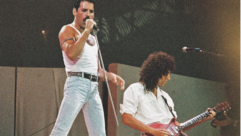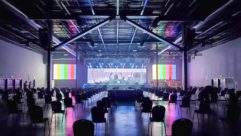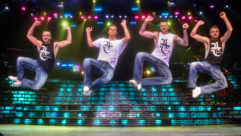Rockin’ the House
Oct 1, 2003 12:00 PM,
By Mike Lethby and Charles Conte
When you set out to entertain a restaurant’s clientele with a blend of good food, a dazzling array of beers, and classic rock music, your design list is likely to be headed by an excellent kitchen, a skillfully run keg room, and a cracking sound system, which is just what Yard House owner Steele Platt had on his agenda when he opened the first Yard House, at Long Beach, California, in 1998.
Yard House is now a steadily expanding chain of leisure restaurants in Southern California, with locations in Costa Mesa, Irvine, and Rancho Mirage. The two most recent openings were Rancho Mirage Palm Springs and, in early 2003, downtown San Diego at the corner of Fourth and Broadway. The restaurants serve American fusion cuisine and claim to offer one of the world’s largest selections of draft beers, boasting keg rooms that each house more than 1,000 gallons of beer. The chain takes its name from the early colonial tradition of serving beer in 36-inch-tall glasses — or yards — to weary stagecoach drivers and acknowledges that tradition by serving its selection of ales in glass yards, as well as half yards and traditional pint glasses. In September 2002, Yard House Restaurants, LLC, signed a development deal with Y. H. Developments, LLC, yielding approximately $24 million in capital, funding that will let the company open six new Yard House restaurants during the next four years. The joint venture will include immediate expansion into the cities of San Diego and Denver. Founder and CEO Steele Platt says the company will double in size within a 12-month period, opening more units outside Southern California, where it made its debut at Shoreline Village in Long Beach.
These large, lively establishments serve up a good deal more than steak, shrimp, and 250 varieties of draft beer. Each entertains waiting diners with a potent in-house A/V system that cranks out pumping rock and onscreen ads, with the music getting turned up to the max on busy weekends.
In charge of the technology to deliver this was Los Angeles-based integrator No Static, a provider of audio, video, and lighting solutions for events and functions, as well as being a design/build firm for permanent installations. No Static has fitted out the A/V systems at each of the Yard House restaurants apart from the original install at Long Beach, where it inherited a previously specified system: “We were brought in there to address some specific issues with the system,” says No Static President Eugene Gordon, “and we’ve continued to work with Yard House as new restaurants have opened.”
The installations to date have featured Renkus-Heinz as the principal loudspeaker brand (the manufacturer also played a substantial role in designing the most recent Yard House systems) and a range of Tannoy and TOA products for various locations, including weather-resistant Tannoy i6AWs and TOA F-121CM wide-dispersion ceiling speakers.
FOOD FOR THOUGHT
No Static’s design brief was straightforward: delivering high-quality rock to the restaurants’ main dining and bar areas, with the capability of driving the system at high levels during the busiest periods. In the two most recent installations, at Irvine Spectrum Center and Rancho Mirage at Palm Springs, space is at a premium, creating a challenge for the designers when it came to positioning the cabinets, particularly subwoofers.
“Yard House was very committed to achieving a high level of audio quality to match the ambience and the quality of food and drinks,” says Gordon. “Although the systems had to deliver good value for money, quality and the capability to run at high levels were the prime considerations at all four sites.
“When we first came onboard with Yard House, they had one restaurant on the waterfront on Long Beach, and there were some ongoing issues with the sound system that had already been installed there. Yard House had appointed a new general manager who we’d worked with before, and he asked us to go in, take a look, and make some recommendations to bring the system up to full performance. We were carrying out system maintenance, performing updates and adding loudspeakers to the system. That project worked out very well, and we were asked to tender for the A/V install at their new restaurant at Costa Mesa in 1999.”
The recently completed Irvine Spectrum Center Yard House, where the entire A/V install came in at more than $200,000, features a substantial system by typical restaurant standards, including no less than 55 Renkus-Heinz cabinets. “We had a number of requirements in deciding which loudspeaker brands to go with,” Gordon says. “Firstly, we wanted to work with a manufacturer who would be able to cooperate with us on various aspects of the system design such as optimizing loudspeaker locations to work with the aesthetics and physical constraints of the space. Second, we needed very compact cabinets that were capable of delivering very high levels when required while sounding excellent, clear, and acoustically transparent at all operating levels. Third, we needed an excellent track record on reliability because some of the Yard House locations are a long drive from our base.”
After considering all the options, No Static settled on Renkus-Heinz loudspeakers for the primary system, because its build-to-order product lineup includes models that seemed to fit the bill in terms of physical characteristics and the essential power-to-size ratio. “They have the capability of working with an integrator to make the most of their products,” Gordon says. “As a company that can build products to order, they would naturally have a deep understanding of acoustic design. We matched those products with others from Tannoy and TOA’s lineups, particularly ceiling loudspeakers.
“Another of the reasons we went with Renkus is that the Yard Houses mostly play classic rock, and most of that stuff was recorded back in the ’60s and ’70s so the sound quality isn’t the greatest, especially compared with today’s recordings. We needed a speaker that ‘doesn’t sound scratchy,’ as Steele puts it. The acoustical problem is that most music from that era can sound quite harsh in the midrange and doesn’t have a lot of bottom end to it, so we needed a box that sounded smooth in the midrange.”
Renkus-Heinz’s senior designer Ralph Heinz, who is the son of company founder Haro Heinz, became involved in the Spectrum Center design at an early stage. “A major issue,” says Gordon, “was that space was at a premium, and there was no room to locate the subwoofers on the floor, so we needed to fly them. That aspect of system design was handled by Renkus-Heinz, who specified the loudspeaker locations for us. It’s nice to work with a manufacturer who can work for you on that level and not just sell the product. Ralph pretty much handled it personally and even came out and EQ’d the system itself, in conjunction with Dave Brown of Audio Gear.”
Another factor was Renkus-Heinz’s experience as worldwide distributor of the EASE program, now in version 4.0. Ralph Heinz and the No Static team employed EASE to evaluate the restaurant’s acoustic characteristics before settling on loudspeaker locations.
“The owner, Steele Platt, really wanted to go with computer modeling,” says Gordon. “Renkus-Heinz provided that right from the start, so the owner was happy that the system’s performance would be highly predictable, and we were able to optimize the efficiency of the system overall by locating the speakers very accurately.”
Forty-two Renkus-Heinz SR82/12A full-range speakers deliver the audio to the bar and dining areas, supplemented by 13 BPS151 subwoofers. They’re driven by a combination of eight Renkus-Heinz P2950D and one P2700 power amplifiers, along with a pair of QSC Audio CX204V amps. The SR82/12A is a built-to-order model that features twin 8-inch woofers and a single 1-inch HF unit, with 120-by-60-degree coverage Complex Conic waveguides in a solid marine ply cabinet. Crucially for this project, this 125 dB (program) loudspeaker measures a diminutive 28½ by 12 by 9¾ inches, allowing unobtrusive mounting over bar tops and on the restaurant’s walls.
“Normally, we would use EASE to determine loudspeaker coverage and intelligibility in large reverberant spaces,” says Ralph Heinz. “In designing for Steele’s vision of how he wanted his restaurants to sound, we used EASE to ensure that stereo was maintained throughout, with seamless transitions from the bar to seating areas. The formula works, and by using high-quality transducers like the SR82, the Yard House maintains higher SPLs [sound-pressure levels] than would be traditional for an eating establishment, yet the Yard House does not sound loud. While the systems installed would be the envy of most high-energy dance clubs, the extra headroom keeps the system out of distortion, even when cranked full. Patrons actually stay longer, mouthing or even singing the words to familiar classic rock, rather than leaving to find a quieter spot somewhere else.”
“The solution met those primary requirements of high levels coupled with high sound quality, because the Renkus-Heinz speakers put out a fairly high SPL and sound flat all the way through,” says Gordon. “It’s pretty exhilarating working with these cabinets. Even though it’s a restaurant, on a weekend when it’s busy, they crank it up pretty loud. Reliability is also an issue for us because it’s a 90-minute drive to Irvine and a 2-hour drive to the Palm Springs location. In fact, although we have the ongoing maintenance contracts for all four Yard House sites, we don’t have any service calls at any of the locations we do; that’s how reliable the gear is.”
IN COMMAND
Music playback is handled by Fidelity Media‘s MegaSeg mobile DJ and radio station automation solution for MP3/QuickTime mixing and programming. Written specifically to run under the UNIX-based Mac OS X on Apple Mac hardware (although it will also run under OS 9), MegaSeg provides music mixing, management of song rotation, timed playlist events and instant playback of drop-in clips and sound effects via Hot Keys.
The new version’s (2.5) scheduling features allow for prioritization of playback for certain songs or entire categories of music, coupled with the ability to start playlists and insert sound clip jingles at specified times. Playlist rules allow the MegaSeg user to prevent two songs from the same artist playing too close together. It can also be used to create dynamic playlists and music scheduling and automatically adjust the volume at different times of the day. Its video playback utilizes QuickTime technology to run Flash animations or music videos, playable in many video formats, including MOV, AVI, and Flash.
“That really is a great package,” says Gordon. “All the music is stored on a hard drive, and the program lets you create different playlists for lunchtime, nighttime, and so on, and because it’s totally computer based, there are no issues of CD players jamming — it’s pretty much 100 percent reliable. That’s one of the reasons Steele used us in the first place. I introduced him to the MegaSeg software, and it solved a major complaint and problem because with their original system at Long Beach, they had a 200-disc CD player that gave them real problems with it jamming all the time.”
The control system is housed in four 7-foot Lowell racks, with an AutoPatch 16-by-40 matrix switcher and a Shure P48000 system processor at the heart of the A/V. A total of 30 JVC televisions — a mixture of 13-, 27-, and 36-inch models — matched to Sony DSS receivers relay the video action to the customers around the restaurant.
The remainders of the public areas are covered by four Tannoy i6AW point-source dual concentric installation loudspeakers and a scuff-resistant polyethylene cabinet designed for wall- or ceilingmounting. The full-range loudspeaker handles 180W program with a 60-degree coverage and peak SPL rated at 118 dB.
In the original Long Beach Yard House, according to Gordon, “the Tannoys were selected for their ability to withstand the exposure to the salt sea air and their excellent sound quality, including their bass response. We wanted a full sound on the patio but did not have the option of installing subwoofers anywhere. The fact that the i6AW sounds so good and is extremely weather resistant made it the obvious choice.” A QSC CX-302V 70V amp powers these 12 loudspeakers. At Irvine the i6AWs cover the outside patio and entry areas. Other areas are covered by TOA F-121CM wide-dispersion ceiling speakers, which feature a concealed diffuser for wide high-frequency coverage and a tuned, ported, bass-reflex enclosure.
“These have been quite unusual installations for a highly experienced client, who knows exactly the effect he wanted to achieve and how the audio ambience would enhance the overall drinking and dining experience,” Gordon says. “The fact also that Yard House has been recognized nationally within the restaurant industry as a groundbreaking concept means it’s something that we’re very proud to have contributed to.”
Mike Lethbyis cofounder of Gasoline Media. He can be contacted at[email protected].
Charles Conteheads Big Media Circus, a marketing communications company. He can be reached at[email protected].
For More Information
AutoPatch
www.autopatch.com
Ž 210
Electro-Voice
www.electrovoice.com
Ž 211
Fidelity Media
www.megaseg.com
Ž 212
JVC
www.jvc.com
Ž 213
Lowell Manufacturing
www.lowellmfg.com
Ž 214
No Static
www.nsav.com
Ž 215
QSC Audio
www.qscaudio.com
Ž 216
Renkus-Heinz
www.renkus-heinz.com
Ž 217
Shure
www.shure.com
Ž 218
Sony
www.sony.com
Ž 219
Tannoy
www.tannoy.com
Ž 220
TOA
www.toaelectronics.com
Ž 221
Ž Circle this number on Reader Service Card or visit freeproductinfo.net/svc









